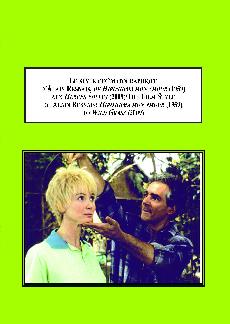This is our backup site. Click here to visit our main site at MellenPress.com
Le Style Cinematographique D'alain Resnais, De Hiroshima Mon Amour (1959) Aux Herbes Folles (2009)

| Author: | Walker-Morrison, Deborah | |
| Year: | 2012 | |
| Pages: | 284 | |
| ISBN: | 0-7734-2630-2 978-0-7734-2630-6 | |
| Price: | $199.95 | |
This text tracks changes in French critical theory on the topic of subjectivity and analyzes how these theoretical developments apply to the films of Alain Resnais. It claims that the purpose of Resnais’ oeuvre is the transition from modernist tendencies towards absolute mastery and control, to postmodern, deconstructionist movements towards a de-centered storyline and subject.
Reviews
“The result [of this book] is an informed and elegant synthesis whose sense of Resnais’ corpus does justice to its cinematic and intellectual uniqueness.”
Prof. Steven Unger,
University of Iowa
“Throughout her analysis, Walker-Morrison draws on an impressive knowledge of critical theory and philosophy to provide highly convincing and surprisingly original readings of a corpus of films that have been the subject of considerable critical discussion. Her analyses draw intelligently on and/or extend the work of key theorists…”
of. Raylene Ramsay,
The University of Auckland
"... Morrison-Walker's meticulously researched and thoughtfully crafted contribution will prove of interest to students and scholars of Resnais' work during this period of reassessment that habitually follows an auteur's passing. Expertly addressing Resnais' well-known themes and distinctive style while offering a perspective that interrogates memory and subjectivity in light of modern and post-modern theory." -Prof. Miriam Thompson, The University of Sydney
Prof. Steven Unger,
University of Iowa
“Throughout her analysis, Walker-Morrison draws on an impressive knowledge of critical theory and philosophy to provide highly convincing and surprisingly original readings of a corpus of films that have been the subject of considerable critical discussion. Her analyses draw intelligently on and/or extend the work of key theorists…”
of. Raylene Ramsay,
The University of Auckland
"... Morrison-Walker's meticulously researched and thoughtfully crafted contribution will prove of interest to students and scholars of Resnais' work during this period of reassessment that habitually follows an auteur's passing. Expertly addressing Resnais' well-known themes and distinctive style while offering a perspective that interrogates memory and subjectivity in light of modern and post-modern theory." -Prof. Miriam Thompson, The University of Sydney
Table of Contents
AVANT-PROPOS en anglais de Francois Thomas
REMERCIEMENTS
Partie I: Introduction
1. Subjectivite: Reflexivite; Postmodernite
Alain Resnais, Vers Une Sagesse Du Postmoderne
Partie II:Enjeux De La Forme dans On Connait La Chanson
2. L’Enonciation Enoncee
3. Sur Les Traces Du Sujet
Partie III: Mise En Ecart Et Fragmentation
4. De La Mise En Abyme A La Mise En Ecart
5. La Mise En Ecart Du Sujet
6. Histoire, Memoire, Imaginaire
Partie IV: Intertextualite et Reinvention
7.Providence: Morts Et Resurrections De L’Auteur
8.Intertextualite, Dialogisme, Contre-Signature
9.La Reapprorpriation de L’Hyptexte
POUR CONCLURE
Bibliographie
Index
REMERCIEMENTS
Partie I: Introduction
1. Subjectivite: Reflexivite; Postmodernite
Alain Resnais, Vers Une Sagesse Du Postmoderne
Partie II:Enjeux De La Forme dans On Connait La Chanson
2. L’Enonciation Enoncee
3. Sur Les Traces Du Sujet
Partie III: Mise En Ecart Et Fragmentation
4. De La Mise En Abyme A La Mise En Ecart
5. La Mise En Ecart Du Sujet
6. Histoire, Memoire, Imaginaire
Partie IV: Intertextualite et Reinvention
7.Providence: Morts Et Resurrections De L’Auteur
8.Intertextualite, Dialogisme, Contre-Signature
9.La Reapprorpriation de L’Hyptexte
POUR CONCLURE
Bibliographie
Index
